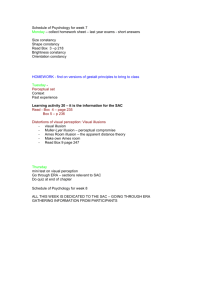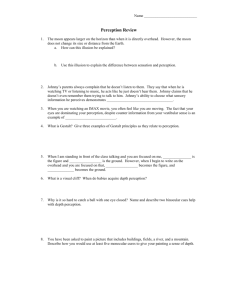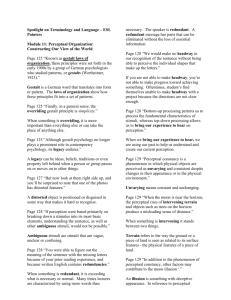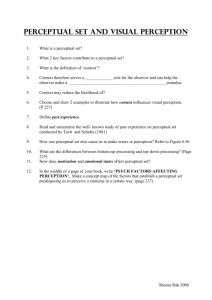Perception
advertisement
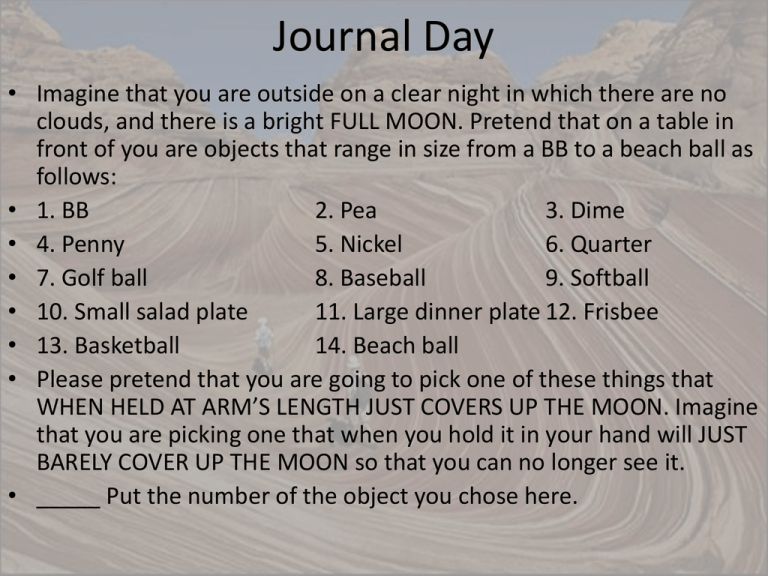
Journal Day • Imagine that you are outside on a clear night in which there are no clouds, and there is a bright FULL MOON. Pretend that on a table in front of you are objects that range in size from a BB to a beach ball as follows: • 1. BB 2. Pea 3. Dime • 4. Penny 5. Nickel 6. Quarter • 7. Golf ball 8. Baseball 9. Softball • 10. Small salad plate 11. Large dinner plate 12. Frisbee • 13. Basketball 14. Beach ball • Please pretend that you are going to pick one of these things that WHEN HELD AT ARM’S LENGTH JUST COVERS UP THE MOON. Imagine that you are picking one that when you hold it in your hand will JUST BARELY COVER UP THE MOON so that you can no longer see it. • _____ Put the number of the object you chose here. Moon Illusion… • The moon is often judged to be 50-75% larger when on the horizon compared to the high sky • There are no definite answers as to why…we only can say it isn’t the Ponzo illusion • Why not? Airplane pilots report similar effects with no horizontal cues • 1 worthy hypothesi s: The mentalsky dome model: The Moon Illusion • Moon Illusion Day • Do you believe in any paranormal phenomena? – – – – – Ghosts UFOs (aliens) Reading people’s minds Predicting the future Telepathic communication • WHY? • OR…Have you ever had personal experiences or know of others who have claimed to have had personal experiences with one of these paranormal phenomena? HW Quiz: 1) Is it a face or a vase? Which term best applies to this “dual” image? 2) What is this apparatus called? 3) If you are in a car staring out the side window (hopefully not while actually driving), what depth perception cue tells allows you to interpret the difference in speed seen in your lower visual field vs. the higher visual field as a sign of depth? 4) 5) In this picture similar to a Necker Cube, what Gestalt principle explains your tendency to see a triangle within this picture? Some Fun… • Changing Illusions...VOLUNTEERS!!!! • 3 Spinning Colors...The Phi Phenomenon with links to all kinds of cool perceptual illusions! • Stepping Feet • Hidden Bird • Necker Cube Illusion; Necker 2 • Why is this? One last afterimage After Image – Whom do you see? Perception & Interpretation Selective Attention • We sense 11,000,000 bits of info / s • We are consciously aware of about 40/s • 1 cool effect – Cocktail Party Effect – DEMONSTRATE (below)– we can selectively listen to only one voice among many; or we can listen in to 1 ear • • • • 3 chairs, 3 volunteers, 2 books Earphones, selective attention! Read some passages from the book Pay attention to info coming into the right ear please. Perceptual Illusions • Café Wall Illusion • Muller-Lyer (below) Perceptual Organization • Visual capture – the tendency for vision to dominate other senses • Can other senses “capture” our attention? YES! • Handout/Visual: Kinesthetic Capture • Visual agnosia – complete sensation of the visual field, but objects seen without meaning” – The Man Who Mistook his Wife for a Hat (Oliver Sacks) (pg. 10) Phonagnosia • Sean Connery Form Perception Form Perception Depth Perception Motion Perception Perceptual Constancies Figure & Ground Relationships • Figure and Ground Relationship Illusion – Figure – any object – Ground – its surroundings – Illusion – it reverses back and forth (237) • Face or Vase? • Paper or Staircase? • Woman? Gestalt – Grouping • Gestalt – German word for form or whole • The whole is > the sum of its parts • Rules for how we bring order to our vision are applied by even 6-month old infants • 5th = Closure – we fill in gaps to create a complete, whole object – Closure Shapes – What is it? • CLASS ACTIVITY ! Depth Perception • Depth Perception – perceiving objects as 3-D when our eyes really only receive and send 2-D image • Visual cliff – had mothers coax infants onto the edge of a safe canyon…most refused to do so…probably instinctual b/c even very young animals (goats, chicks) do this too page 238 Depth Perception: Binocular cues – DEMONSTRATION • • • • • Hold two pencils with two hands out in front of you Touch them together Now, do it with one eye closed WHY is it easier with 2 eyes?? 1) Retinal disparity – the difference between the two images your eyes project to the brain (Another Demonstration: finger sausage) • 2) Convergence – Kinesthetic cue; – muscles causing eyes to turn inward is interpreted as “closer” The Pulfrich Pendulum Effect (skip in 10-10) Depth Perception • Biological Motion: Biological Motion? • Kinetic Depth: Globe or Circle? • Disappearing Act • 1 More Motion After Effect: The Rising Waterfall Monocular Cues No One Gets Why on This… Monocular Cues • Linear perspective – parallel lines converge • Ponzo Illusion • Ponzo Illusion (playground) Light & Shadow • Nearby objects reflect more light to our eyes. Thus, two identical objects, if one appears dimmer, it seems farther away Motion Perception • Phi Phenomenon – an illusion of movement when two or more adjacent lights blink on and off in succession • Over the Mountain Stroboscopic movement – Movies, cartoons, etc. are just a fast succession of slides Perceptual Constancy • Perceiving objects as unchanging even as illumination and retinal images change • Shape and Size Constancies – Size Constancy – we perceive objects as having a constant size, despite that our distance from them varies • Variation in Retinal Size – even though the retinal image/size changes, our perception of the size usually doesn’t…this is size constancy • Demonstrations: – 1) Enlarging finger – 2) The floating X (thanks to afterimages) The Ames Room • http://www.youtube.com/watch?v=5ic7QGjG EX8 (2 dudes walking corner to corner) • http://www.youtube.com/watch?v=Ttd0YjXF0 no (Ramachandran explains it) • How do these terms relate? – Relative size – Monocular cues – Retinal size – Size constancy Muller-Lyer Explained • Relative Depth mistakes • City buildings vs. Inside corners… – Line running down the outside corner is the closest – Line running up the back corner is further away – Same image, brain adjusts • The brain realizes that this line is really shorter than it appears when compared to the rest of the building. • Muller-Lyer Illusion • The T Illusion or Horizontal Vertical Lines Illusions Unexplainable Illusion? Poggendorf • Distance? Shape? Constancies??? – Poggendorf – Poggendorff Illusion – Poggendorf with Extravagant Explanationswith explanation Perceptual Constancy – Light • Perceived lightness = relative luminance (the amount of light an object reflects relative to its surroundings) (similar to color constancy) – White paper reflects 90% of light – Black paper reflects 10% of light • In sunlight, black paper actually may reflect 100x more light than white paper indoors, but black is still black, and white is still white… • Simultaneous Contrast • Munker-White Illusion • Stepping Feet (kinesthetic color contrast) Perceptual Interpretation Sensory Deprivation • Ppl born with cataracts, then removed…could distinguish btwn figure and ground (innate) but could not recognize objects by sight that were familiar by touch • Monkeys born and outfitted with goggles that allowed only diffuse, unpatterned light…following infancy, remove goggles, could distinguish color and brightness, but not form of a circle or square (cortex lacked the normal connections to recognize these) • Feature Detection: Kitten born in darkness, except for 5 hours when placed in a horizontally or vertically striped environment (249)…later, the kittens had trouble recognizing the other shape – Would only play with a rod when held upright if raised in the vertical environment and vice versa • All this suggests a CRITICAL PERIOD for normal sensory and perceptual development…more on this in Developmental. Psych. Chapter Perceptual Adaptation • Chicks fitted with lenses that changes the location of objects 40 degrees to the left do not adapt…they continually peck at where the feed seems to be • Upside down lenses (Mind vid?) – Humans, kittens, monkeys can adapt • We do not turn in back to right side up, we just learn to do it upside down (upside down just seems normal then) – Fish, frogs, salamanders cannot Perceptual Set!! • The true “Cognitive Expectations” part of perception • What number follows each of these (DON’T GO ON!! READ TO THEM!!)? • 32 • 73 • 373 • 2624 • 4099 • Why? Perceptual Set!! • • • • • Pronounce these words aloud! MAC DONALD MAC HENRY MAC MAHON MAC HINERY • • • • “TIME FLIES I CANT THEYRE TOO FAST.” MAKE SOME MEANING OUT OF THIS. CANT? TRY TIME AS THE VERB AND FLIES AS THE NOUN. TIME THE FLIES! GET IT? Perceptual Set CHO PHO USE Perceptual Set • Sally announces to her kindergarten classmates that today is the birthday of both her father and her grandfather. Both are exactly 50. Her teacher says that’s impossible. Is Sally right? • My page 20 Perceptual Set • STORY TIME!!! • End of year teacher gifts (20) • Another STORY! 6 volunteers • Did the stories change? (21) – show page Perceptual Set • MORE STORY TIME!!! • TELEPHONE GAME AGAIN!!! How stories can be changed by our expectations! • (STORY ON NEXT PAGE 4 after the game) • 1) Leveling – perceiver drops details that do not fit the assumptions • 2) Sharpening – details consistent with values and interests of perceiver are emphasized • 3) Assimilation – padding and organization are used to make the central theme fit the subject’s expectations Three men, masked and armed with pistols, robbed the Glenwood State Bank yesterday morning at 9:30 AM.They escaped in a Ford two-door bearing a 1971 Connecticut license plate, taking $647 in coins and $2,190 in fivedollar bills. A lieutenant in the Marines claims he saw the car going north at noon yesterday. Perceptual Set – Context Effects • Dead or Asleep – Transporting dead patients through the hospital…just uncover their faces! Expectations • • • • • • • • • What do these letters spell? FOLK How about these? CROAK And what do these letters spell? SOAK What do we call the white of an egg? YOLK! NOPE! Human Factors Psychology • A branch of psychology that explores how people and machines interact and how machines and physical environment can be adapted to human behaviors – Mapping of the stove controls (255) – Examples of Bad Human Designs (23) Parapsychology Extrasensory Perception -- Parapsychology • Parapsychology – the study of paranormal phenomena or ESP (Extra Sensory Perception) such as: • Telekinesis or psycho kinesis – mind over matter (levitating a table or influencing the roll of dice) • Clairvoyance – perceiving remote events (a friend’s house is on fire) • Precognition – perceiving future events • Telepathy – reading another person’s mind Precognition • Me 25 #1 • Tom Cruise’s movie…? Mr. Flip is Telepathic • Please write one thing about yourself on this slip of paper and seal in it the envelope I provided. • • • • 3 students leave the room Class now select a card randomly here Call back students Students out of the room…one of you call my telepathic friend…number is on the podium…dial 9 first! Premonitions or Pretensions? • National Enquirer made 486 predictions between 1978 and 1985…only 2 came true • The Farmers Almanac once predicted that it would snow 3 times in July in Florida…and it did… • Police dept. psychics make no more accurate guesses than average individuals…or vague explanations can be refitted in hindsight • Given enough time, improbable becomes inevitable • Goldman, Sachs, and Comp. (investing banking firm) now offers $1 million to anyone who can prove they have a genuine psychic power…no takers yet (roughly 30 years now…used to be $10,000)…many tested, none for real • MONTEL: SYLVIA! • Browne debunked ESP Tested • “A reproducible ESP phenomenon has never been discovered, nor has anyone produced any individual who can convincingly demonstrate psychic ability” – (Myers, 2004, 2010) • Psychology is not closed minded about ESP – ESP should be testable and provable, so the fact that we haven’t found it out there means we cannot accept it as a truth…will this hold forever? Who knows? • Page 263…ESP-N • Let’s find out if anyone is capable of precognition, clairvoyance, or telepathy


